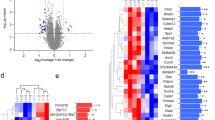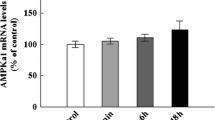Abstract
To have more insight into the mechanism of neuronal injury in phenylketonuria (PKU) patients, gene expression profiles were studied in cell culture of embryonic rat cortical neurons induced by phenylalanine. Randomly chose cortical cultured for 3 days were treated by 0.9-mM phenylalanine for 12 h. Control group of the same batch was treated with the same volume of medium. Total RNA was extracted and hybridized with the Affymetrix gene chip U34 according to the protocol provided by the Affymetrix Company. Real-time PCR was used to further confirm the result. We found that the hybridization signals of 167 genes were increased among the total 1323 probes plotted on the chip. The 167 increased genes could be functionally categorized into signal transduction, neuron related, cytoskeleton, metabolism, ion channels, transcription factors, cytokines, and apoptosis related. Signals of seven probes were decreased, which accounted to 0.5% of the total number. A series of genes that were not reported previously were upregulated by phenylalanine, including Ca2+/calmodulin-dependent protein kinase, Brain type II (CaMK II), ras, P38, L-voltage dependent calcium channel, some genes related to vesicle formation and transmitter release, some glutamate receptor subunits and glutamate transporters. According to the gene expression profiles, it is likely that multiprocesses are involved in the neuronal injury induced by phenylalanine, such as the activation on of the NMDR-Ca2+–CaMK II–Ras–P38 axis, the abnormality in neurotransmitter release. Our study also suggests that the excitatory neurotransmitter glutamate may play a role in the neural pathology of PKU.
Similar content being viewed by others
References
Calcutt, N.A., Tomlison, D.R., and Bisbwas, S. (1990). Co-existence of nerve conduction deficit with increased Na+, K+-ATPases activity. Diabetes 36:663–666.
Chen, H.J., Rojas-Soto, M., Oguni, A., and Kennedy, M.B. (1998). A synaptic Ras-GTPase activating protein (p135 SynGAP) inhibited by CaM kinase II. Neuron 20:895–904.
Costabeber, E., Kessler, A., Severo Dutra-Filho, C., de Souza Wyse, A.T., Wajner, M., and Wannmacher, C.M. (2003). Hyperphenylalaninemia reduces creatine kinase activity in the cerebral cortex of rats. Int. J. Dev. Neurosci. 21:111–116.
Dunican, D.J., and Doherty, P. (2000). The generation of localized calcium rises mediated by cell adhesion moleculars and their role in neuronal growth cone motility. Mol. Cell. Bio. Res. Commu. 3:255–263.
Dyer, C.A. (2000). Comments on neuropathology of phenylketonuria. Eur. J. Pediatr. 159:S107–S108.
Dyer, C.A., Kendler, A., Jean-Guillaume, D., Awatramani, R., Lee, A., Mason, L.M., and Kamholz, J. (2000). GFAP-positive and myelin marker-positive glia in normal and pathological environments. J. Neurosci. Res. 60:412–426.
Dyer, C.A., Kendler, A., Philibotte, T., Gardiner, P., Cruz, J., and Levy, H.L. (1996). Evidence for central nevous systerm glial cell plasticity in phenylketonuria. J. Neuropath. Exp. Neurol. 54:852–863.
Dzhura, I., Naidenov, V., Zhuravleva, S., Kostyuk, P., and Shuba, Y. (1998). Expression of Ca2+ channels from rat brain with model phenylketonuria in xenopus oocytes. Brain Res. 783:280–285.
Glushakov, A.V., Dennis, D.M., Morey, T.E., Sumners, C., Cucchiara, R.F., Seubert, C.N., and Martynyuk, A.E. (2002). Specific inhibition of N-methyl-D-aspartate receptor function in rat hippocampal neurons by L-phenylalanine at concentrations observed during phenylketonuria. Mol. Psychiatry 7:359–367.
Gu, X.F., Yang, X.W., and Chen, R.G. (2000). Possible mechanism of nerve damage on hyperphenylalanine in embryonic rat. Am. J. Hum. Genet. 67:S281.
Gupta, R.P., Bing, G., Hong, J.S., and Abou-Donia, M.B. (1998). cDNA cloning and sequencing of Ca2+/calmodulin-dependent protein kinase II alpha subunit and its mRNA expression in diisopropyl phosphorofluoridate (DFP)-treated hen central nervous system. Mol. Cell. Biochem. 181:29–39.
Lockhart, D.J., Dong, H., Byrne, M.C., Follettie, M.T., Gallo, M.V., Chee, M.S., Mittmann, M., Wang, C., Kobayashi, M., Horton, H., and Brown, E.L. (1996). Expression monitoring by hybridization to high-density oligonucleotide arrays. Nat. Biotechnol. 14:1675–1680.
Martinez-Cruz, F., Pozo, D., Osuna, C., Espinar, A., Marchante, C., and Guerrero, J.M. (2002). Oxidative stress induced by phenylketonuria in the rat: Prevention by melatonin, Vitamin E., and Vitamin C. J. Neurosci. Res. 69:550–558.
Mirnics, K. (2001). Microarrays in brain research: The good, the bad and the ugly. Nat. Rev. Neurosci. 2:444–447.
Moller, H.E., Weglage, J., Bick, U., Wiedermann, D., Feldmann, R., and Ullrich, K. (2003). Brain imaging and proton magnetic resonance spectroscopy in patients with phenylketonuria. Pediatrics 112(6, Pt. 2):1580–1583.
Pascucci, T., Ventura, R., Puglisi-Allegra, S., and Cabib, S. (2002). Deficits in brain serotonin synthesis in a genetic mouse model of phenylketonuria. Neuroreport 13:2561–2564.
Pfaffl, M.W., Horgan, G.W., and Dempfle, L. (2002). Relative expression software tool (REST©) for group-wise comparison and statistical analysis of relative expression results in real time PCR. Nucleic Acids Res. 30: e36.
Roricht, S., Meyer, B.U., Irlbacher, K., and Ludolph, A.C. (1999). Impairment of callosal and corticospinal system function in adolescents with early-treated phenylketonuria: A transcranial magnetic stimulation study. J. Neurol. 246:21–30.
Schulpis, K.H., Tjamouranis, J., Karikas, G.A., Michelakakis, H., and Tsakiris, S. (2002). In vivo effects of high phenylanine blood levels on Na+, K+-ATPase, Mg2+-ATPase activities and biogenic amine concentrations in phenylketonuria. Clin. Biochem. 35:281–285.
Shefer, S., Tint, G.S., Jean-Guillaume, D., Daikhin, E., Kendler, A., Nguyen, L.B., Yudkoff, M., and Dyer, C.A. (2000). Is there a relationship between 3-hydroxy-3-methylglutaryl coenzyme A reductase activity and forebrain pathology in the PKU mouse? J. Neurosci. Res. 61:549–563.
Sierra, C., Vilaseca, M.A., Moyano, D., Brandi, N., Campistol, J., Lambruschini, N., Cambra, F.J., Deulofeu, R., and Mira, A. (1998). Antioxidant status in hyperphenylalaninemia. Clin. Chim. Acta 276:1–9.
Song, G., Dhodda, V.K., Blei, A.T., Dempsey, R.J., and Rao, V.L. (2002). GeneChip analysis shows altered mRNA expression of transcripts of neurotransmitter and signal transduction pathways in the cerebral cortex of potacaval shunted rats. J. Neurosci. Res. 68:730–737.
Tsakiris, S. (2001). Effects of L-phenylalanine on acetylcholinesterase and Na+, K+-ATPase activities in adult and aged rat brain. Mech. AgeingDev. 122:491–501.
Yamauchi, T., Yoshimura, Y., Nomura, T., Fujii, M., and Sugiura, H. (1998). Neurite outgrowth of neuroblastoma cells overexpressing alpha and beta isoforms of Ca2+/calmodulin-dependent protein kinase II-effects of protein kinase inhibitors. Brain Res. Brain Res. Protoc. 2:250–258.
Yang, X.W., Gu, X.F., and Chen, R.G. (2000). Toxic effects of phenylacetic acid to cultured rat cortical neurons. Chinese J. Neurosci. 16:330–332.
Zhang, H.-W., Lu, J.-Q., and Gu, X.-F. (2003). Expression of two neuron developmental associated genes induced by hyper-phenylalanine with real time quantitative RT-PCR. Chin. Lab. J. 26:273–276.
Author information
Authors and Affiliations
Corresponding author
Rights and permissions
About this article
Cite this article
Zhang, H., Gu, X.F. A Study of Gene Expression Profiles of Cultured Embryonic Rat Neurons Induced by Phenylalanine. Metab Brain Dis 20, 61–72 (2005). https://doi.org/10.1007/s11011-005-2477-y
Received:
Accepted:
Issue Date:
DOI: https://doi.org/10.1007/s11011-005-2477-y




